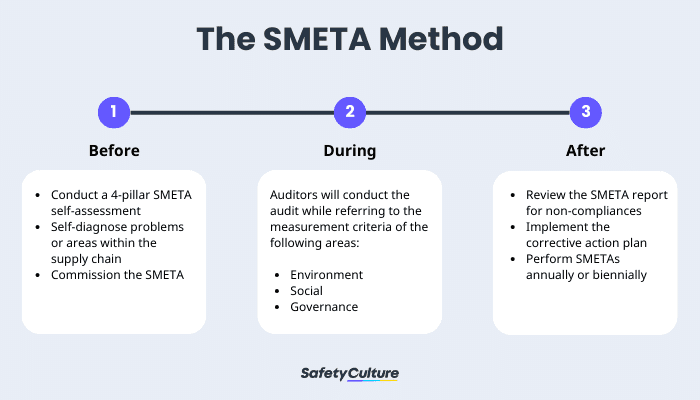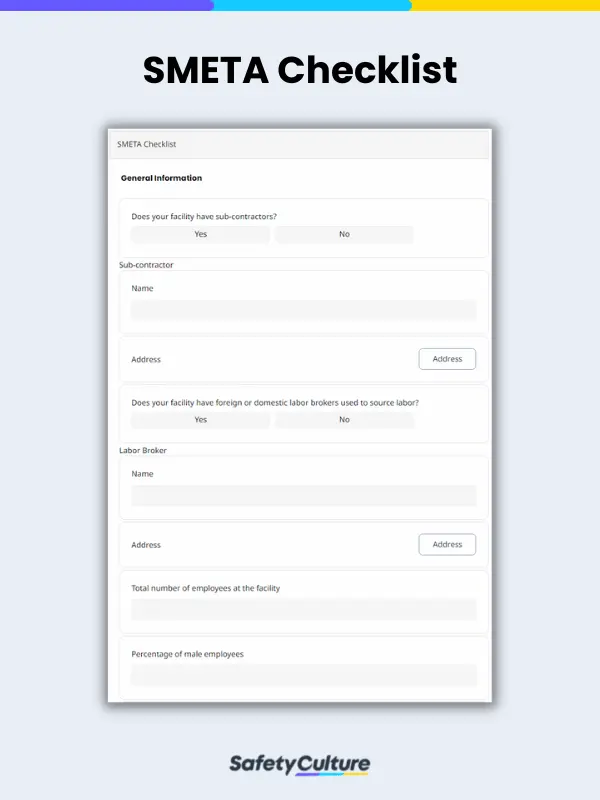What is SMETA?
SMETA (Sedex Members Ethical Trade Audit) is an audit method used across 150 countries to evaluate all aspects of responsible business practice in global supply chains. Specifically, the 4-pillar SMETA encompasses labor standards, health and safety, the environment, and business ethics. The Supplier Ethical Data Exchange (Sedex) developed SMETA for suppliers to share ethical practices and reduce audit duplication, saving time, money, and resources.
What is a SMETA Checklist?
A SMETA checklist is an audit tool used across various industries—manufacturing, agriculture, engineering, service providers, and intermediaries—to assess performance of the four pillars prior to annual or biennial SMETAs. SMETA checklists aim to help suppliers perform self-assessments, determine strengths and areas of improvement, and achieve greater visibility into their supply chain.
The Value of SMETA
“Ethical business conduct is, at its core, a principles-based or values-based approach to the way an organization operates,” said Andrew Blasi, Director of a leading international trade and regulatory affairs consulting firm.
Suppliers that do not value or fail to demonstrate value for human rights, safety, and the environment are less sustainable in a global marketplace. Their customers will turn to competitors, and their most talented employees will also look for a different place to work.
An ethical trade audit such as SMETA can help global buyers and suppliers such as retail brands, manufacturers, international agents and even single production sites, optimize their supply chain to meet or exceed the demands of today’s economy, while demonstrating responsible business practice.
The SMETA Method
As an audit method, SMETA makes it easier for companies to determine their strengths and drive continuous improvement in their supply chain. Here is an overview of how the SMETA works:

Before the SMETA
- Conduct a 4-pillar SMETA self-assessment based on industry best practices such as ISO 14001:2015, OHSAS 18001, and more.
- Self-diagnose problems or areas within the supply chain that are prone to issues and correct them prior to the SMETA conducted by second- or third-party auditors.
- Commission the SMETA and expect an announced, semi-announced, or unannounced audit at your site(s).
During the SMETA
Refer to the following measurement criteria used by auditors:
Environment
- Management Systems and Training
- Greenhouse Gas Emissions and Energy Usage
- Air Emissions
- Water Management
- Waste Management
- Packaging
- Pollution Prevention
- Other Raw Materials
- Transportation
Social
- Workplace Management
- Health and Safety
- Emergency Management
- Forced Labor
- Child Labor and Young Workers
- Discrimination
- Freedom of Association and Collective Bargaining
- Harassment and Abuse
- Compensation
- Hours of Work
Governance
- Accountability
- Grievance and Remediation
- Supplier Management
- Stakeholder Engagement
After the SMETA
- Review the SMETA report for recorded non-compliances (e.g. failing to meet local and national regulatory requirements), raised observations (e.g. no system in place to monitor performance), and good examples or exceptionally good performance of the four key pillars.
- Implement the corrective action plan and validate its effectiveness.
- Perform SMETAs annually or biennially to continuously optimize your supply chain and improve your demonstration of responsible business practice.



